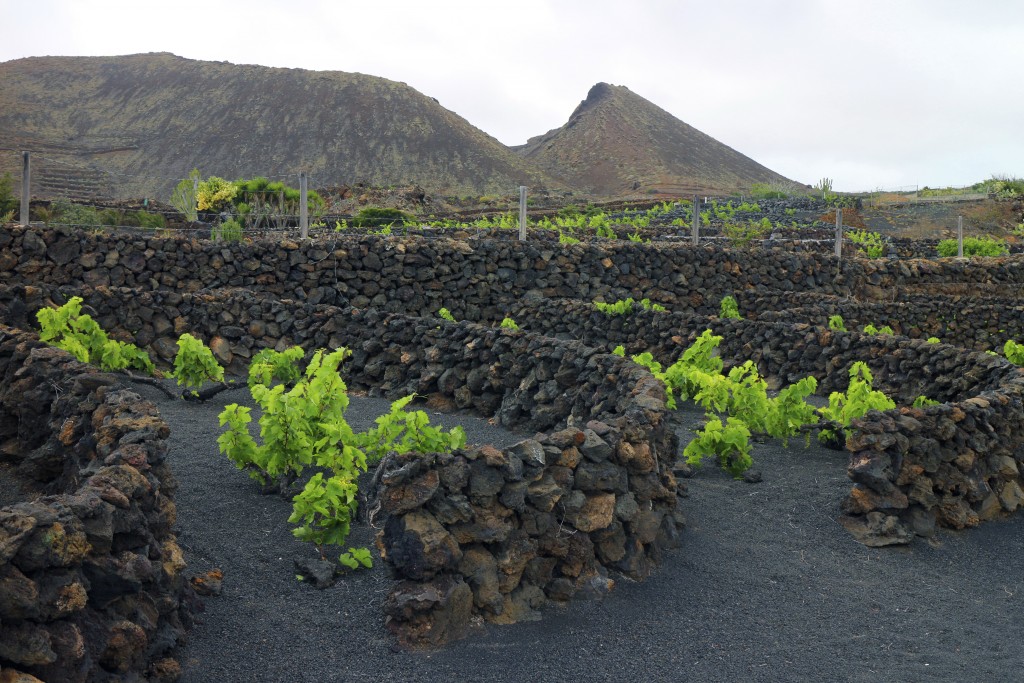 Continued from Part 1: Volcanic Wine
Continued from Part 1: Volcanic Wine
Leaving the tourist stop, I fold myself back into my five-inch Fiat. It takes about ten hours drive to the top of the volcano, though I’m not going that far today.
Still, with every twist and turn in the road that takes me higher up the mountain, my ears pop and my heart beats faster, wondering whether I’ll come head-on with a tour bus barreling downwards.
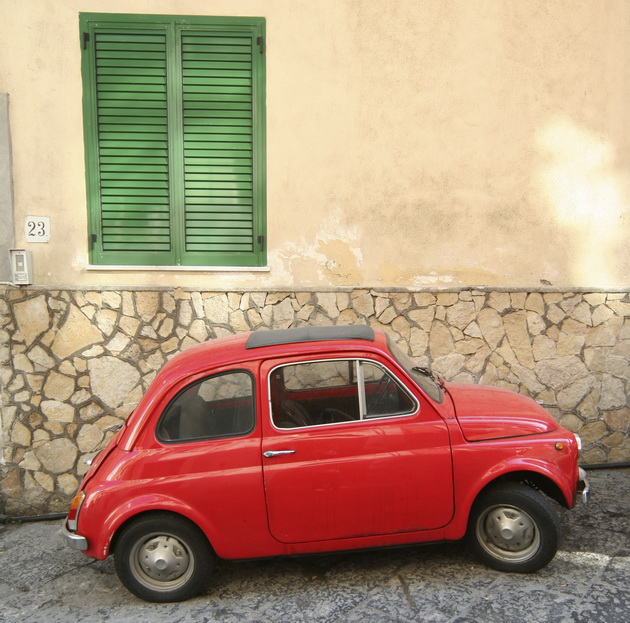 Out of the corner of my eye, I see vineyards tucked between the medieval villages, chunks of volcanic stone in marvelously strange shapes crouch between the vines.
Out of the corner of my eye, I see vineyards tucked between the medieval villages, chunks of volcanic stone in marvelously strange shapes crouch between the vines.
I’m on my way to meet Giuseppe Benanti, of Vinicola Benanti, a vineyard that’s been in his family for eleven generations. I finally arrive, shaken but safe, in front of the stone winery that clings to the hillside like a small gray boat on a rolling ocean of green.
The land has belonged to the family since 1734, when King Vittorio Amadeo II granted 320 hectares in the village of Catania to his faithful servant Antonio Benanti. The Benanti family were knights for the king, and he wanted to establish a large and loyal clan in southern Italy.
I learn this family history from Lisa Sapienza, the winery’s export sales director, a beautifully coiffed woman with red-polished nails.
She also outlines the business goals to merge science and tradition, which usually translates to: We’re using fancy technology to improve profits, but we keep our historical look in the brochures for branding purposes.
She leads me into the oak-paneled hall to meet Giuseppe Benanti, great-great-grandson of Antonio. He looks just like the successful pharmaceutical executive he is: mid-sixties, silver-framed glasses, Armani suit, quizzical expression.
His features resemble those of his ancestors in the gold-framed portraits along the walls who seem to be watching us.
Giuseppe sits at the head of the oak table to my right, while Lisa sits across from me to translate, since apparently Giuseppe’s English is not strong.
Giuseppe’s father, Lisa explains, taught cataract surgery at the University of Catania, preferring the sterile environment of the operating room to the family business.
He didn’t want muddy shoes, Lisa explains. He died in 1958 and the vineyards sat dormant for four decades until Giuseppe decided to revive the winery in 1988.
As Lisa translates, Giuseppe watches me with his head cocked to one side and a faint smile. I nod and smile too much at both of them, unnerved by this conversation that makes me feel like Alice with the Queen of Hearts and the Cheshire cat in the tree.
Although he had followed in his father’s footsteps, earning a doctorate in chemistry and pharmacy, Giuseppe remembered harvests with his grandfather: the grapes that smelled so sweet, the workers who sang the old songs, the outdoor feasts with everyone gathered around the table.
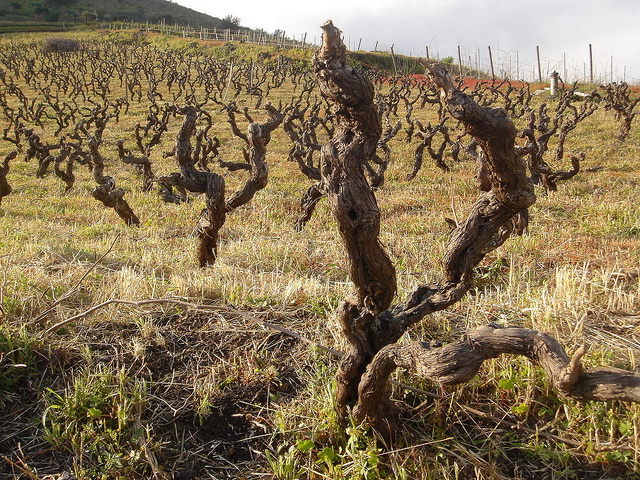 His first challenge was buying back the estate, which had been divided among seventeen cousins. (“The first sixteen were no problem—it was the seventeenth who gave all the trouble.”).
His first challenge was buying back the estate, which had been divided among seventeen cousins. (“The first sixteen were no problem—it was the seventeenth who gave all the trouble.”).
Next, he hired local winemaker Salvo Foti, who was working just a few miles down the road, making wine for Mick Hucknall, lead singer of Simply Red.
After centuries of assaults from various countries, the latest invaders of the island are celebrities: Hucknall, Madonna, and Gérard Depardieu all own wineries here.
Hucknall called his wine Il Cantante, the singer. Though why he didn’t use Simply Red and Simply White is a mystery—and a lost co-branding opportunity.
Unlike Diego Planeta, Giuseppe decided not to plant any international grapes. (“When in Rome, why eat at McDonald’s?”) Nor did he choose nero d’avola, which doesn’t grow well in volcanic soil. Instead, he focused on Etna’s two specialty red varieties: nerello mascalese and nerello cappuccio.
These grapes are variations of the nerello mother vine, one of the oldest on the planet. They don’t grow well anywhere else, but thrive on Etna’s ashen slopes, producing incredibly complex wines.
Mascalese is planted more widely than cappuccio: it’s a slow ripener planted higher up the mountain, so it’s often not picked until late October. The grape knows how to hold its acids and tannins and yields wines with long aging potential.
Cappuccio ripens earlier and is picked in September; it’s fleshier and rounder, with very little tannin. The two grapes are often blended: mascalese has a cabernet character, cappuccio is considered more merlot-like. Rumor has it that almost a century ago, when Bordeaux suffered a vineyard blight, nerello was sold there as the local wine and few people noticed the difference.
As Lisa is explaining Giuseppe’s one hundred and fifty trials on fermentation methods, he takes a small camera from his coat pocket and starts taking pictures of me.
For the first few shots, I turn to smile at the camera, as if this is, of course, an expected part of an interview for any journalist.
But when he starts tilting the camera this way and that, moving closer across the table and then pulling back for different angles, I become fascinated with Lisa’s explanation of the fourteen yeasts that were tested.
“Dr. Benanti is a true visionary,” Lisa says. I also suspect that he may be a lonely visionary, as the white flashes that continue to my right.
“He has brought forth the wines that best express the indigenous soil and the indigenous mind. He believes there is a difference between 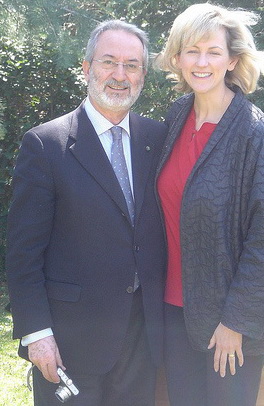 wines merely produced on Etna, and Etna wines made by Etna people.”
wines merely produced on Etna, and Etna wines made by Etna people.”
“Mano Uona Etna,” Giuseppe says, setting down the camera. “Etna Man,” Lisa translates. The door opens with the welcome distraction of an assistant carrying several bottles and three glasses.
“Si, i vini, they speak for themselves,” Giuseppe says with surprisingly good English. “They speak better than we do, so let’s taste!”
He pours his Rovittello, a blend of nerello mascalese and nerello cappuccio, from eighty-year-old vines. The wine has aromas of fresh-turned earth, dried tobacco and blackberries. As the wine matures, the oak notes will recede as the tertiary nuances—aromas that develop from bottle age—emerge, such as leather and violets.
“We are pursuing the ancient fragrances,” Giuseppe says as we savor the wine.
Next we try his Serra della Contessa. Drinking it is like plunging head-first into a vat of fleshy plums. There’s a mild tingling in the mouth from the dark spices, then a mouth-watering acidity that washes it away on soft layers of ripe blackberries that roll over each other.
This makes you wonder if your first impression of the wine was correct. Naturally, you must take another drink to confirm. Giuseppe and I are confirming many impressions, while Lisa is now absorbed in her BlackBerry e-mail.
“White wines must be young and fresh,” Giuseppe says, smiling slyly, “but reds just get better with age.”
Although Sicily is better known for its red wines, being more climatically suited to making them, two-thirds of the island’s grapes are white.
Most were originally selected for their resilience to extreme heat and drought. Obscure varieties such as grillo, grecanico, carricante, catarratto, damaschino and insolia delivered large yields and were fermented at high temperatures, which resulted in whites that were tired and oxidized.
Today, though, improved techniques, such as night harvesting and temperature-controlled fermentation, prevent premature fermentation and allow the fresh fruit character to come through. Modern Sicilian whites are crisp, clean, and zesty.
Sadly, few of them travel well, so they’re often not sold abroad. These lovely local wines are best consumed in Sicily, preferably on a sun-drenched terrace overlooking the dazzling Mediterranean. Sipping them is like staying at a small family-run inn rather than a big chain hotel.
Giuseppe pours me his Benanti Biancodicaselle, a zesty white made from the carricante grape with an apricot-lemon core. Tasting these strange and wonderful wines is like discovering an island of gem-colored butterflies when you’ve been living among moths.
“When I taste the wine, I see the vineyard,” Giuseppe says enthusiastically. “You must see the vineyards, come!” As I marvel at how quickly he has become fully bilingual, we leave Lisa at the table, clicking away at her e-mail, and head out into the fresh morning air.
Giuseppe’s vines are cultivated using the ancient alberello method: low freestanding bushes tied to wooden stakes. The volcanic soil extends down a good thirty-five feet, giving the vines a longer life—many are more than a hundred years old.
Vines of this age, Giuseppe believes, are best tended by people of the same age: “They understand each other.” Walking through this forest of gnarled stumps makes me feel like a giant stomping through a magical forest where the trees might come alive any moment and wrap their limbs around my legs.
Giuseppe possesses each vine with his eyes. There is a fierce, visceral attachment to the land here: some families have owned their vineyards for generations, even if they’ve let them grow wild.
Family-run operations have usually long since paid off their property and capital costs, so their wine prices don’t have to account for these costs.
Many of them are more interested in preserving the family name on the label than in making an overpriced “badge wine.” There’s another reason why wine is so affordable here: it’s an intrinsic part of the culture. The diversity of the industry in terms of grapes, styles, prices and quality is the result of a strong domestic market.
As we walk, Giuseppe plucks a stray leaf here and a dead branch there. “Winegrowers don’t like things to come to an end: we are perpetual tinkerers,” he tells me. “We know our vines personally and individually. When we prune one, we know exactly where to put our shears without thinking—like a lover when you put your hand on her waist.”
His next question takes me by surprise: “Have you ever suffered from cenosilicaphobia?”
Huh?
When I ask him what that means, he shakes his finger at me, with a conspiratorial smile: “Ah, only a crafty wine journalist would pretend she didn’t know what cenosilicaphobia is. Very disarming, brilliant!”
“No, I can assure you that I’m just an ignorant wine journalist,” I say, hugging my embarrassment. “I’m really just a highly functioning liver with a few superfluous organs attached.”
Giuseppe laughs dismissively, refusing to believe me—or perhaps refusing to believe that he’s spending so much time with someone who hasn’t heard of cenosilicaphobia. So I admit reluctantly to having felt it once or twice, but not recently, still wondering what on earth he’s referring to. Later when I check online, I discover that it means “fear of an empty glass.”
Ceno comes from the Greek word for empty (as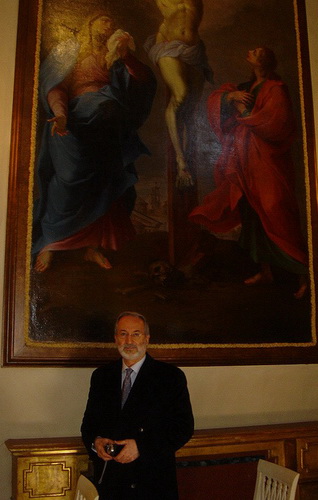 in cenotaph, an empty tomb) and silica is the Roman word for glass. Occupational hazard for those in the wine biz, I guess.
in cenotaph, an empty tomb) and silica is the Roman word for glass. Occupational hazard for those in the wine biz, I guess.
“Would you like to see my chapel?” Giuseppe asks me next, spider cunning in his eyes. “We are no longer sconosciuti (strangers),” he says, wrapping his forearm in mine. It’s an offer from a Sicilian vintner I can’t refuse.
We walk down the cobblestoned path through the vineyards to a small white building, nestled amid silvery olive trees.
The late-morning light burnishes the stained-glass windows and the golden pointed spire.
Inside, a 25-foot ceiling invites my eyes upwards.
Large oil paintings of biblical scenes hang on the walls along with wooden crosses.
Giuseppe takes me up to the tiny choir loft that overlooks two pews facing the small alter below.
As we lean over the balcony, light streaming in through the windows like a Vermeer painting, he starts singing a Latin hymn. His rich, baritone voice fills the chapel.
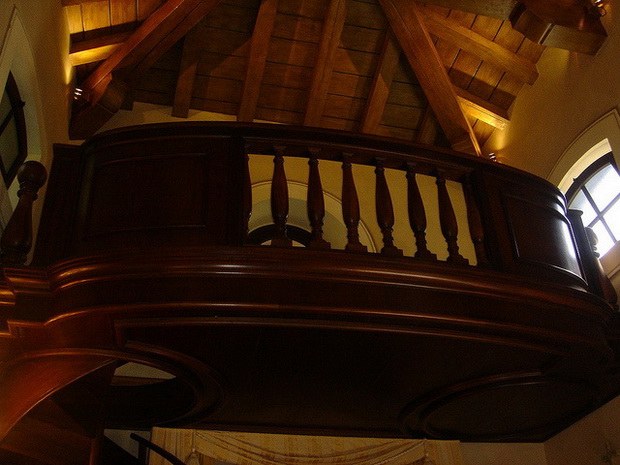 Then he stops, we smile in the silence and walk downstairs.
Then he stops, we smile in the silence and walk downstairs.
It is a contemplative end to the visit. As we say goodbye, Giuseppe says something to Lisa in Italian, his English has mysteriously vanished again.
He looks away shyly as she translates: “Dr. Benanti says you ask questions with your heart. He hopes there is a good man at your side.”
I smile at Giuseppe as we kiss on both cheeks, twice. When I climb back into my Fiat, Lisa walks back into the winery.
Giuseppe stands in front of the chapel, waving.
Continue to Part 3: Etna Wine







